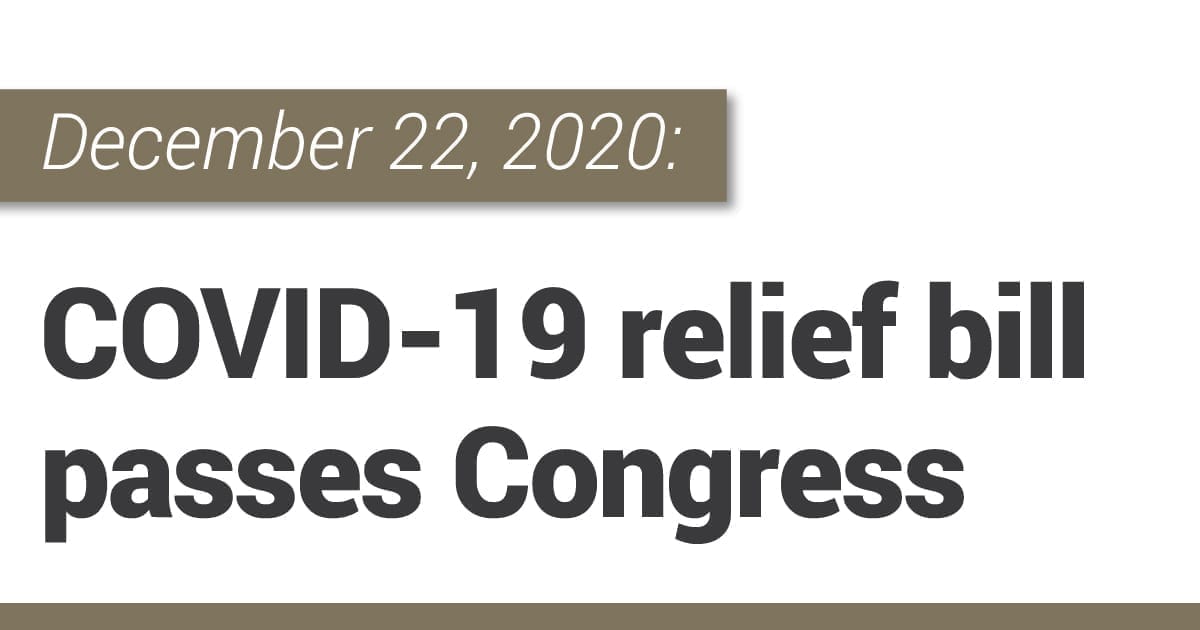The U.S. Senate and House of Representatives passed the much anticipated $900 billion COVID-19 relief bill late Monday night. The nearly 5,600-page Consolidated Appropriations Act, 2021 bill includes many key provisions. Here are some of the more notable provisions that may have an impact on you or your business:
- $325 billion in aid for small businesses struggling after nine months of pandemic-induced economic hardships. The bill provides more than $284 billion to the U.S. Small Business Association (SBA) for first and second PPP forgivable small business loans and allocates $20 billion to provide Economic Injury Disaster Loan (EIDL) Grants to businesses in low-income communities. In addition, shuttered live venues, independent movie theaters, and cultural institutions will have access to $15 billion in dedicated funding, while $12 billion will be set aside to help businesses in low-income and minority communities.
- $166 billion in economic impact payments of $600 for individuals making up to $75,000 per year and $1,200 for married couples making up to $150,000 per year, as well as a $600 payment for each child dependent.
- $120 billion to provide workers receiving unemployment benefits a $300 per week supplement from December 26 until March 14, 2021. This bill also extends the Pandemic Unemployment Assistance (PUA) program, with expanded coverage to the self-employed, gig workers, and others in nontraditional employment. Also extended is the Pandemic Emergency Unemployment Compensation (PEUC) program, which provides additional weeks of federally funded unemployment benefits to individuals who exhaust their regular state benefits.
- $25 billion in emergency rental aid and an extension of the national eviction moratorium through January 31, 2021.
- $45 billion in transportation funding, including $16 billion for airlines, $14 billion for transit systems, $10 billion for state highways, $2 billion each for airports and intercity buses, and $1 billion for Amtrak.
- $82 billion in funding for colleges and schools, including support for HVAC repair and replacement to mitigate virus transmission and $10 billion in child care assistance.
- $22 billion for health-related expenses incurred by state, local, Tribal, and territorial governments.
- $13 billion for emergency food assistance, including a 15% increase for six months in Supplemental Nutrition Assistance Program benefits.
- $7 billion for broadband expansion.
PPP Loans
Included in the bill were some provisions to the original PPP loan program (PPP1) that will bring relief to many business owners:
- Business expenses equal to the forgiven PPP1 loan amount will be deductible to businesses.
- Simplified PPP loan forgiveness will be available for loans of $150,000 or less. This is expected to be a one-page certification on the number of employees the borrower could retain because of the loan, the estimated total amount spent on payroll costs, and the total loan amount. The bill’s language states that the SBA must create this simplified application within 24 days of the bill’s enactment. The borrower is required to keep supporting documents are these loans will be subject to random audits.
- PPP loan borrowers will not have to deduct the EIDL advance from their PPP loan forgiveness.
The $325 billion available for PPP2 loan comes with new eligibility requirements. The PPP2 loans will be available to first-time qualified borrowers and businesses that previously received a PPP loan. The PPP2 requirements are:
- Small businesses must have 300 or fewer employees.
- Previous PPP loans must have exhausted all of the original loan funds.
- Must show a 25% gross revenue decline in any 2020 quarter compared to the same quarter in 2019.
PPP2 will also permit first-time loans to Sect. 501(c)6 businesses, businesses with 500 or fewer employees eligible for other SBA 7(a) loans, sole proprietors, independent contractors, and eligible self-employed individuals. Accommodation and food service businesses will be eligible for larger loans based on 3.5 times their average monthly payroll costs, rather than 2.5 times for other industries.
PPP2 has also expanded the qualified expenses allowed in the forgiveness calculations, including supplier costs, operating costs, property damage due to civil unrest, and facility modifications to mitigate the spread of COVID-19. The bill’s language states the SBA has 10 days from enactment to provide details on the types of documentation required to apply for PPP2 and further clarify the expanded qualified expenses.
The new PPP2 loan applications are expected to open in early January 2021. If you intend to apply for a PPP2 loan, we encourage you to start gathering your information now. As we receive additional clarification on the SBA requirements for these PPP2 loans, we will forward those to you.
In addition to the myriad of items already listed, the bill also included funding to keep the government open until September 30, 2021, plus making permanent or extending additional tax provisions set to expire on December 31, 2020.
As more information becomes available from the almost 5,600-page bill review over the next few days, we will provide updates.
